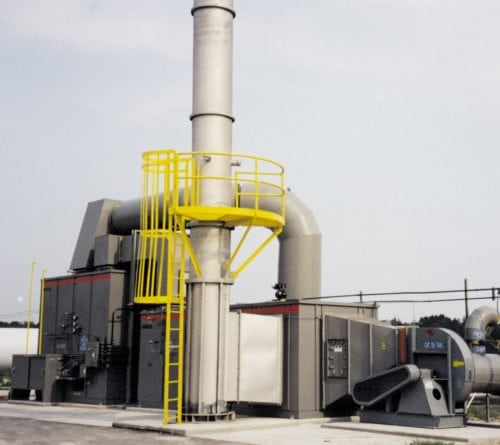 The Challenge
The Challenge
A major chemical manufacturer required a pollution control system with minimal operational cost to destroy the Hazardous Air Pollutant (HAP) by-products of a formaldehyde production process. A key issue was system reliability; the plant operates 24 hours a day and only shuts down once per year for plant-wide preventive maintenance.
The Solution
After thorough technical evaluation, the company selected Anguil Environmental Systems, Inc. to solve their HAPs emission problem and put them in compliance. Anguil installed a catalytic oxidation system that meets all applicable regulatory requirements. The system uses a 65% effective shell and tube heat exchanger that allows self-sufficient operation under normal process loadings.
In the formaldehyde production process, methanol reacts with air in the presence of catalyst to produce formaldehyde. Process yields are normally quite high, with over 95% to 98% of methanol ending up as formaldehyde. Some ancillary compounds are generated in the oxidation process due to catalyst inefficiencies. The emission by-products that require control are carbon monoxide, dimethyl ether, methanol and formaldehyde. Both formaldehyde and methanol are classified as Hazardous Air Pollutants (HAPs) and require stringent emission reduction.
Anguil’s extensive experience with formaldehyde manufacturers helped the company in examining possible pollution control solutions. On this application conditions were favorable to use a catalyst for VOC control. Since the customer uses catalyst in their process, they were comfortable using catalyst for VOC and CO oxidation. In addition, there is a relatively high CO and VOC concentration exhausted from the process which would allow the catalytic oxidizer to function without any auxiliary energy requirement.
A precious metal catalyst was selected as the core of the catalytic system due to its ability to provide 99+% DRE of the formaldehyde, methanol, dimethyl ether, and carbon monoxide at a catalyst bed inlet temperature as low as 525° F (275° C). The catalyst is deposited on a monolithic, honeycomb, stainless steel substrate. The catalyst design minimizes the pressure drop through the oxidizer.
Another cost-effective design feature was the integral 65% effective shell and tube heat exchanger that was selected to preheat the incoming process stream prior to the catalyst bed. The exhaust air from the catalyst outlet is hot sufficient to keep the oxidizer operating at temperature with no auxiliary energy requirements.
Oxidizer warm-up following a plant shut-down was also a crucial design consideration. Neither natural gas nor propane is readily available at many of the company’s formaldehyde plants. For this reason an electric heating system was selected to bring the oxidizer up to the 525° F operational temperature prior to the processing of the plant off-gases. A small pre-heat fan and an electric heater were designed to bring the system up to initial operating conditions. Once at setpoint temperature, the oxidizer process inlet valve is incrementally opened to allow the process exhaust gases. As sufficient CO/HAP/VOC loading enters the oxidizer releasing heat from the exothermic reaction, the electric preheat elements shut off completely. No additional energy is added to the system. In fact, the oxidizer doesn’t even use fan energy since it takes advantage of the process pressure to push through the oxidizer.
The Result
The system is operating and providing well over the 99+% destruction efficiency required. The success of this system resulted in this chemical company purchasing another 25 and counting additional Anguil systems for formaldehyde plants around the world. Anguil’s experience, innovative design and quality manufacturing resulted in another satisfied Anguil customer and a long-term partner with air pollution control.

 The Challenge
The Challenge